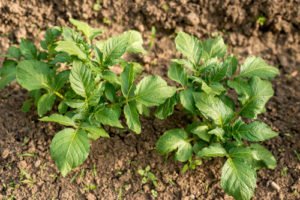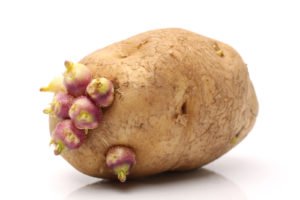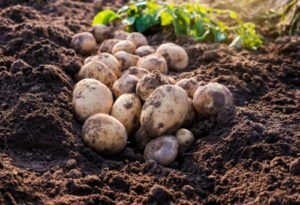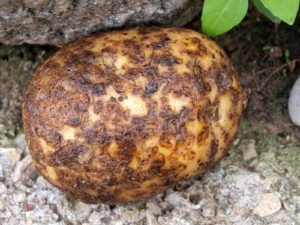The potato and its origins
The potato is a type of root vegetable that is classified as an edible tuber. The plant itself is a herbaceous perennial variety of nightshade, with by far the most common species being the Solanum tuberosum.

It is believed the potato was first cultivated in South America up to 10,000 years ago. There are now some 5,000 varieties of farmed potato throughout the world. There are also around 200 varieties of wild potato to be found throughout the Americas. It has been found that all wild and cultivated potatoes descend from a just a handful of species of the plant. However, more than 99% of all cultivated potatoes are directedly descended from a single species that originates from the lowlands of south-central Chile.
Potatoes were first introduced to Europe from the Americas in the mid-16th century by the Spanish. And famously to Britain, by explorer and naval commander Sir Walter Raleigh. Today, the potato is a staple food across many parts of the globe, being the world’s fourth-largest food crop after corn, wheat, and rice. It’s also the most grown vegetable throughout the world’s temperate regions.
Seed potatoes

The potato is grown from its own edible tubers of the previous season, which are known as ‘seed’ potatoes. While in theory, it’s possible to use any potato as a seed, in practice you should only use officially ‘certified’ seed potatoes, since they are guaranteed to be disease-free, and hence, much more likely to produce high yielding, good quality crop. Ideally, a seed potato should be the size of a hen’s egg, since larger seeds tend to produce too many sprouts. Small seeds will produce only three or four sprouts which are the ideal for producing maximum crop yields.
Potato seeds are classified in accordance with the time they will be ready to harvest. Earlies are ready in June to July; second earlies in August to early September; and main crop from mid-September to October. Most varieties of potato have either white or red skins and white or pale-yellow flesh.
Cultivation
Soil
Potatoes can be successfully grown in a wide variety of soils but grow best in deep, fertile, well-drained soils that have been enhanced with sufficient bulky organic manure to retain moisture during dry spells. Chose a planting bed in an open, sunny position but away from any frost pockets. Make sure you do not apply lime to the planting bed as potatoes grow best in conditions of pH 5.0 to 6.0 and alkaline conditions also tend to favour potato scab disease.
Dig in the well-rotted manure or compost to your soil bed in Autumn at a rate of around 8 – 10 kg per sq metre. In Spring, fork over the ground and rake-in an all-purpose fertilizer at a rate of around 1 kg per 8 sq metres.
Planting
In the UK, seed potatoes should be planted: late March, for first earlies; early to mid-April, for second earlies; and mid to late April, for main crops.
General procedure:
- Plant the ‘seeds’ with the eyes facing upwards in 6” (150 mm) deep drills.
- Earlies should be planted with 12” (300 mm) spacings, and second earlies and main crop with 16” (400 mm) spacings, in rows 24” (600 mm) apart.
- Cover the drills immediately after planting with a relatively fine tilth up to ground level.
- Drawing up a mound 4” – 6” high over the planted rows, leaving a series of ridges and furrows
- Hoe the furrows between the ridges on a regular basis, watering as necessary during dry weather.
- Hoe the soil from the furrows into the ridges around the growing plants at 2-3 weeks intervals until ridges reach a height of about 12”.
Watering
Earlies should be watered every 12 to 14 days from an early stage of growth for maximum yields. The rate of watering should be around 15 litres per m2. Main crops should be watered when the plants begin to flower at a rate of around 20 litres per m2. This will greatly increase the potential yield and will help to protect against potato scab.
Harvesting

Earlies should be ready around 3 months after planting, in June or July, second earlies in July and August, maincrops from late August through to October. Early potatoes will be ready for lifting when the flowers are fully open. For maincrop potatoes, lift approximately 10 days after the foliage begins to turn yellow. After lifting, leave the tubers on the soil surface for 2 to 3 hours to dry off. In wet conditions move the crop to a sheltered place to dry off. Make sure all crop has been lifted so that the potential to spread disease from old potatoes remaining in the ground to new harvest is eliminated.
Common diseases
Potato blight
Potato blight is the worst of disease to affect a crop. It occurs in wet, warm, humid conditions that can occur in the UK from July onwards. The initial sign of the blight is yellow blotches that appear on the leaves of the plant. The blotches rapidly turn brown, affecting both leaves and stems, killing the plant in the worst attacks, which becomes a watery rot. The fungal spores can then be washed into the soil affecting the developing tuber crop, turning them to a rotten mush. Once blight starts, it is very difficult to stop.
Removing blight-affected leaves may help, but removing too many leaves will damage the plant’s ability to grow. There are some blight-resistant cultivars which will obviously lessen the chance of the disease developing. However, spraying plants with the likes of ‘mancozeb’ (or similar) every 10 days when favourable disease conditions are experienced, should help greatly.
Potato blackleg
Potato blackleg is a common bacterial disease which causes black rotting at the base of the plant’ stem. Initial infections can stunt growth and yellow stems. If tubers have formed, then the flesh may be grey or brown and rotten. Any infected plants should be removed and appropriately disposed of offsite. Some varieties such as ‘Charlotte’, ‘Pixie’ and ‘Saxon’ offer good resistance to the disease.
Potato scab
Potato scab causes raised scab-like lesions on the surface of a potato. However, it does not affect the taste and is easily removed on peeling. Potato scab doesn’t usually become apparent until harvest time and there is no absolute control against it. However, it is much more prevalent in alkaline soils and dry soil conditions, so keep potatoes well-watered. Make sure you don’t store any potatoes that have the scab.
Potato rot
Potato rot is a frequent cause of loss of crop both prior to, and after, lifting. The disease usually follows a wet growing season, particularly if the crop is lifted in very wet soil conditions. To minimise the chances of potato rot, use only good quality, resistant certified seed tubers when planting. Harvest the crop when the soil is neither too wet nor too dry. Always store in cool, dry conditions.
Popular Varieties
- Picasso – heavy-cropping main crop potato with a creamy skin, which has good disease resistance to scab.
- Desiree – one of the country’s favourites, it’s a versatile main crop potato, which has a rosy skin and pale-yellow flesh.
- Charlotte – the nation’s top salad potato, is an early crop tuber with yellow waxy skin.
If you’ve enjoyed reading this article, why not click on the link to Hobbies and Pastimes, to see if there’s anything else that takes your interest?







[…] potatoes is easiest in a grow […]